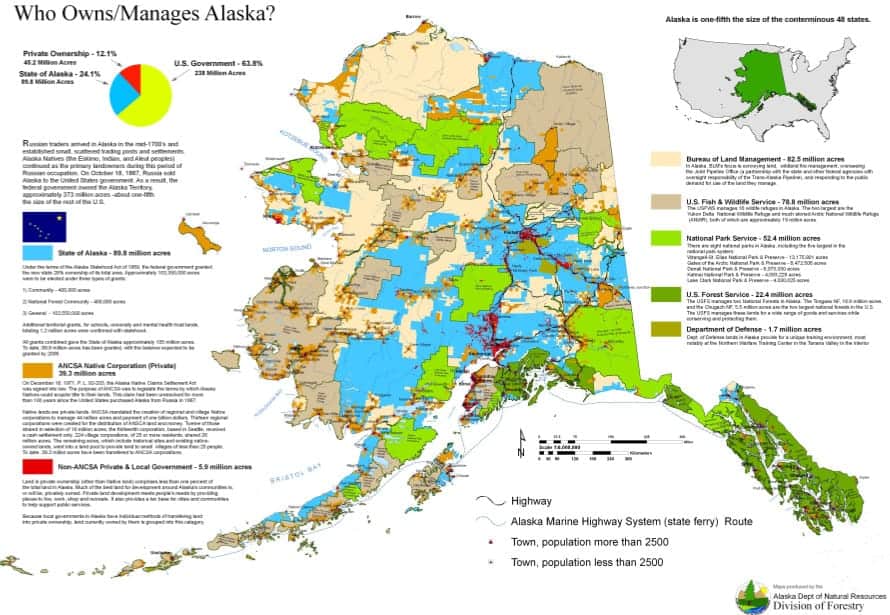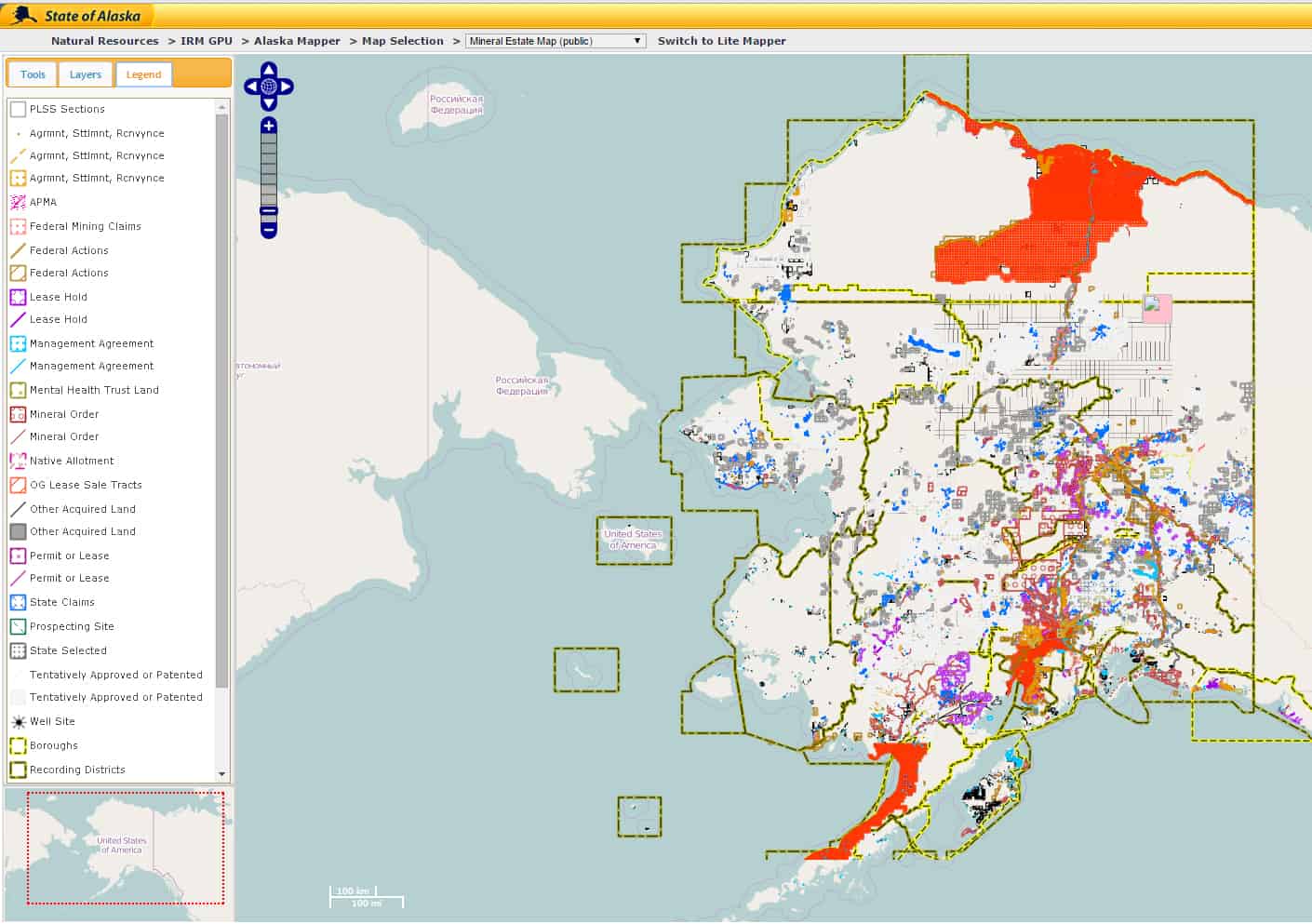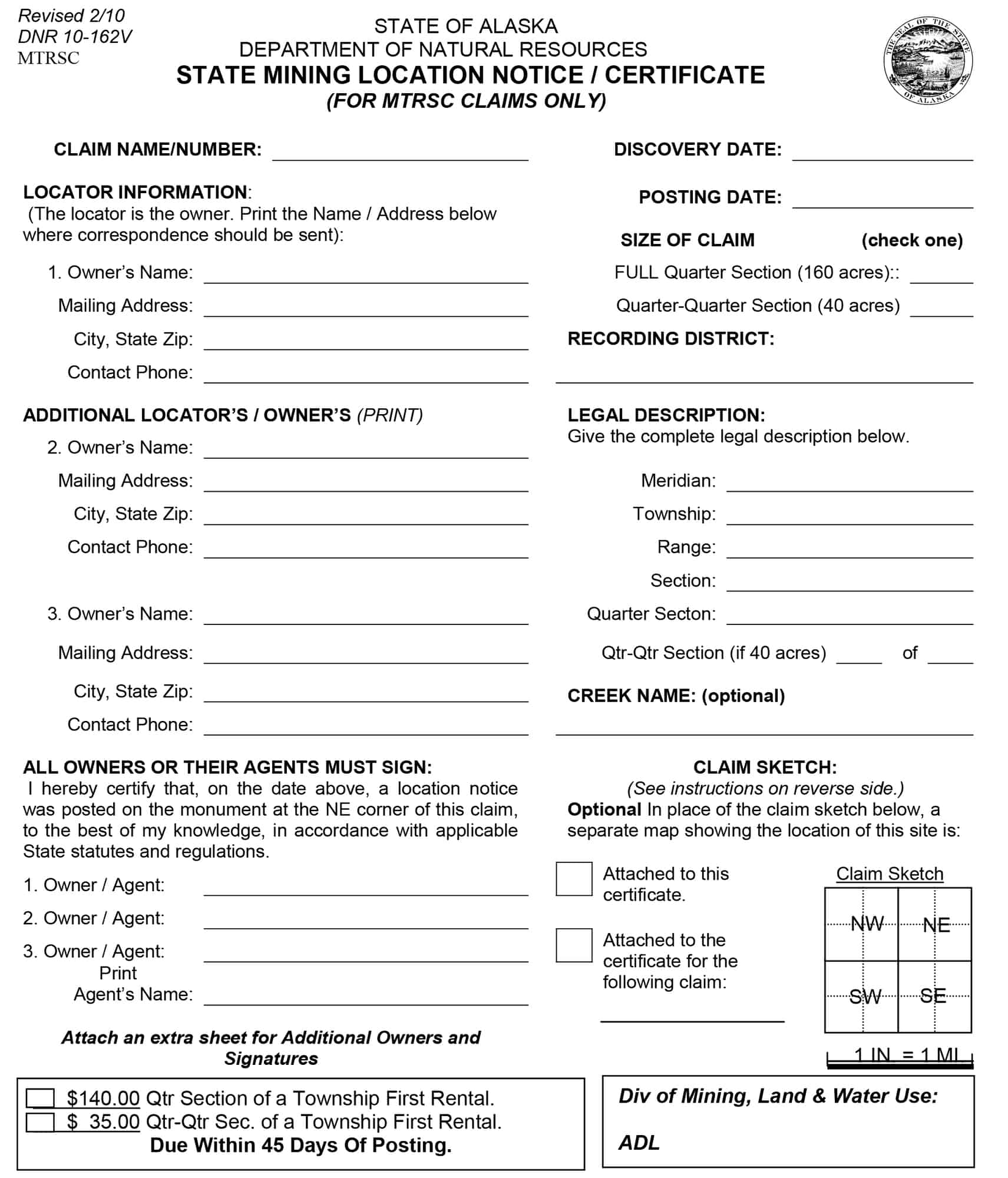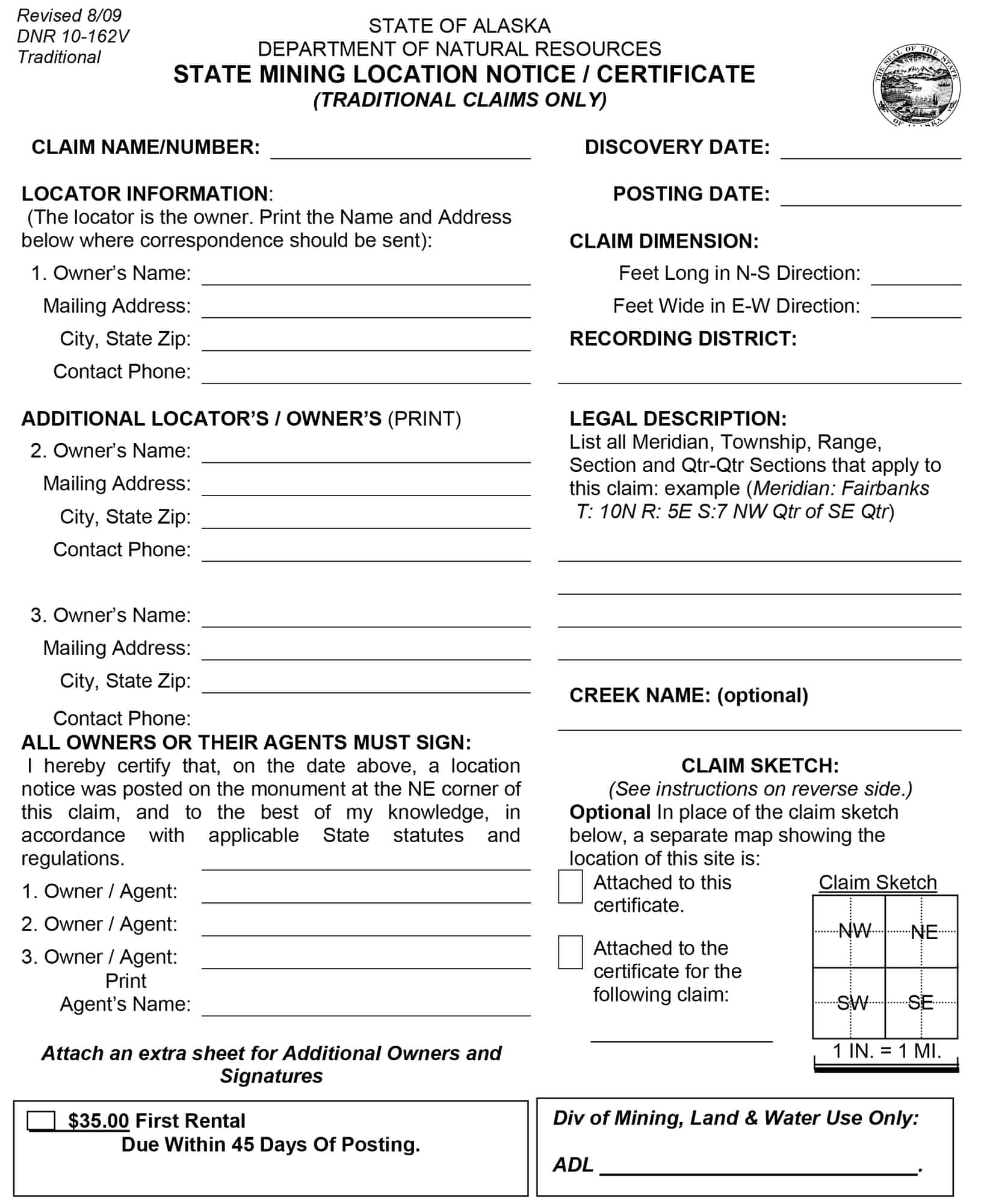Alaska: Big, beautiful, wild, and full of opportunities.
The rugged expanse of Alaska has posed many challenges for its explorers and inhabitants over the centuries, and there is no doubt that it still poses these same challenges today. As with most things in life though, where you find great challenges you are also bound to find great opportunities. In this case, we are talking about opportunities to stake claims in Alaska and develop the amazing mineral riches of the last frontier. Staking claims in Alaska is a different process from what you may be used to on federal lands, we will cover the primary differences in this article.

Alaska is like many of the other Western States in that much of its land is controlled by federal and state agencies. Much of this land is also open to mineral entry and available for mining claims. Staking claims in Alaska on state lands varies significantly from the process of staking federal mining claims. In this article we are going to cover the basic requirements and key differences to be aware of when staking claims in Alaska on state lands.
Staking claims in Alaska: Finding open ground

In Alaska there are 89.8 million acres of state lands; many of these state lands are concentrated around mining districts that are currently producing or have produced in the past. You will find that the process of finding open ground for prospecting and staking claims in Alaska is easy. The Alaska Division of Natural Resources (DNR) provides an interactive mapping tool that shows the location of all active, closed, and pending claims in the state, including federal mining claims. This tool makes it easy to find areas that are open for staking claims and prospecting, and is also useful for finding areas that have been active with Alaska mining claims in the past. The Alaska DNR mineral estate map can be found here. Familiarizing yourself with the use of the Alaska Mapper tool and mineral estate map is your first step toward staking claims in Alaska.
Staking claims in Alaska on state lands involves a location, rent, and production royalty system. When staking claims in Alaska there is no differentiation between lode and placer claims – an Alaska state claim covers both types of mineral deposits. Let’s take a look at the specific requirements and regulations that surround staking mining claims in Alaska.
Staking claims in Alaska: A quick glance
Qualifications: The qualifications for staking claims in Alaska are similar to the regulations imposed on federal claims by the General Mining Act of 1872.
Discovery: Before staking claims in Alaska is it important to be able to justify that the claim has the potential to eventually be developed into a paying mine. This discovery can be proven through a variety of prudent exploration and sampling measures.
Recording: Certificates of location are recorded in the Recording District Office in which the claim has been staked within 45 days of posting the notice of location in the field.
Claim Sizes: When staking claims in Alaska there are three different claim sizes; these sizes are generally selected to suit the nature and footprint of the mineral deposit that the claimant wishes to secure. Quarter section MTRSC claims cover 160 acres. Unlike federal associated placer claims of this size, quarter section MTRSC claims can be located by one or more individuals. Quarter-quarter section MTRSC claims are 40 acres. Traditional claims are no more 1,320 feet in the longest dimension, and are generally 40 acres as well.
Marking locations: In similar fashion to federal mining claims, it is a requirement to erect at each corner of the claim a substantial monument of stone or posts. The corner markers should not be less than three feet in height, and not less than two and one-half inches in diameter. They should be marked with the name of the location and the number of the monument, beginning with number 1 at the northeast corner and proceeding in a clockwise direction around the location. Where it is impractical to place a monument in its true position, a witness monument can be erected and marked to indicate the true position of the corner. The location notice should be posted in the northeast corner of the claim when staking claims in Alaska.
Annual Labor: Claim improvement labor must be performed annually with an affidavit recorded each year in the Recording District Office in which the claim is located. An annual labor affidavit is due every year on September 1st and is $100 per standard claim and $400 for quarter section claims. While the labor performed staking claims in Alaska does not count toward the annual labor requirement, other improvement and exploration activities do qualify.
Annual Rental: The amount of annual rental due varies depending on the size of the claim and the number of years that it has been held. The Alaska state mining claims rental year begins at noon on September 1 and ends at noon on September 1 of the following year. Payments must be received no later than November 30 of the same year.
Royalty: If there is mineral production occurring on the mining claim, a state production royalty must be paid annually. It is important for anyone considering staking mining claims in Alaska to be aware that royalty payments will be required when a claim is producing.
Staking claims in Alaska: Claim paperwork


The Alaska state mining location notice/certificate for traditional claims can be downloaded here.
The Alaska state mining location notice/certificate (for MTRS claims only) can be downloaded here.
All other mining forms related to mining and staking claims in Alaska can be found on this page.
Staking claims in Alaska: The rules and regulations
These are the rules and regulations as contained in the Alaska Statutes, Alaska Administrative Code, and Article 8 of the Alaska State Constitution that affect staking claims in Alaska on state lands. The full handbook can be downloaded here.
Qualifications: Sec. 38.05.190
(a) The right to acquire exploration and mining rights under AS 38.05.185 – 38.05.275 may be acquired or held only by
(1) citizens of the United States at least 18 years of age;
(2) legal guardians or trustees of citizens of the United States under 18 years of age on behalf of the citizens;
(3) persons at least 18 years of age who have declared their intention to become citizens of the United States;
(4) aliens at least 18 years of age if the laws of their country grant like privileges to citizens of the United States;
(5) corporations organized under the laws of the United States or of any state or territory of the United States and qualified to do business in this state;
(6) associations of persons described in (1) – (5) of this subsection.
An unqualified person who acquires an interest in exploration or mining rights by operation of law shall be allowed two years in which to become qualified or to dispose of the interest to a qualified person
Mining claims: Sec. 38.05.195.
(a) Rights to deposits of minerals subject to AS 38.05.185 – 38.05.275 in or on state land that is open to claim staking may be acquired by discovery, location, and recording as prescribed in AS 38.05.185 – 38.05.275. The locator has the exclusive right of possession and extraction of the minerals subject to AS 38.05.185 – 38.05.275 lying within the boundaries of the claim.
(b) The locator may locate a claim using one of the following methods:
(1) a locator may locate a claim based on the ground location of a complete quarter section or quarter-quarter section of a township on a rectangular survey system approved by the commissioner; a claim established in this manner may be known as the meridian, township, range, section, and claim system location, or MTRSC location; a locator using the MTRSC system to locate a claim shall in good faith mark the corners of a location as closely as practical to the existing quarter section or quarter-quarter section of the rectangular survey system approved by the commissioner; the corners marked on the ground of a claim established in accordance with this paragraph and regulations of the commissioner control in the event of a conflict over boundaries for the quarter section or quarter-quarter section on the protracted or actual survey approved by the commissioner; or
(2) a locator may locate a claim based on the staking of a ground location in which the claim may not exceed 1,320 feet in its longest dimension; the boundaries of a claim based on staking and located after January 1, 1985, shall run in the four cardinal directions unless the claim is a fractional claim or the commissioner determines that staking in compliance with this paragraph is impractical because of local topography or because of the location of other claims; a claim established in this manner may be known as a non-MTRSC location.
(c) A location’s corners shall be distinctly marked on the ground in the manner prescribed by the commissioner, and a notice of location shall be attached to a monument at the claim’s northeast corner in the manner and containing the information required by the commissioner. Within 45 days after the date of attaching the notice of location on the monument, the locator shall record a certificate of location in the recording district where the claim is located. The certificate of location must contain the information required by the commissioner.
(d) Locations may be amended in the manner and with the effect prescribed in AS 38.05.200. Annual labor shall be performed and statements of annual labor recorded as prescribed in AS 38.05.210 – 38.05.235.
Annual labor: Sec. 38.05.210.
(a) Labor shall be performed or improvements made annually on or for the benefit or development of each mining claim, leasehold location, and mining lease on state land except that, where adjacent claims, leasehold locations, or mining leases are held in common, the expenditure may be made on any one claim, leasehold location, or mining lease. The commissioner shall establish the date of the commencement of the year during which the labor or improvements are to be performed. Labor shall be performed at the following annual rates:
(1) $100 per claim, leasehold location, or lease if the claim, leasehold location, or lease is a quarter-quarter section MTRSC claim, leasehold location, or lease;
(2) $400 for each quarter section MTRSC claim, leasehold location, or lease; and
(3) $100 for each partial or whole 40 acres of each mining claim, leasehold location, or lease not established using the MTRSC system. If more work is performed than is required by this section to be performed in any one year, the excess value may be applied against labor required to be done during the subsequent year or years, for as many as four years. Instead of performing annual labor, the holder of a claim, leasehold location, or mining lease may make a cash payment to the state equal to the value of the labor required by this subsection.
(b) During the year in which annual labor is required or within 90 days after the close of that year, the owner of the mining claim, leasehold location, or mining lease, or some other person having knowledge of the facts shall record with the recorder of the district in which the claim, leasehold location, or mining lease is located a signed statement setting out the information, as may be required by the commissioner, concerning the annual labor of the preceding year, any labor in excess of that required for the preceding year, and any payment of cash instead of annual labor. The statement, properly recorded, is prima facie evidence of the performance of the labor. The failure of one of several co-owners to contribute the proportion of the expenditures required for annual labor from the co-owner shall be treated in accordance with AS 38.05.215 – 38.05.235.
(c) The statement of annual labor required in (b) of this section may be amended within two years of the date by which the annual labor statement was required to be recorded. An amended statement shall be recorded for record in the same manner as the original statement. Additional labor claimed in an amended statement may not be applied against labor required to be done during a subsequent year.
Annual rental: Sec. 38.05.211.
(a) The holder of each mining claim, leasehold location, prospecting site, and mining lease, including a mining lease under AS 38.05.250, shall pay, in advance, rental for the right to continue to hold the mining claim, leasehold location, prospecting site, and mining lease, including a mining lease under AS 38.05.250. Rental is due and payable as follows:
(1) the rental amount for a prospecting site is fixed at $200 for the two-year term of the site;
(2) annual rental for a mining claim, leasehold location, or mining lease shall be based on the number of years since a mining claim, a leasehold location, or a mining lease’s predecessor claim or leasehold location was first located; the annual rental amounts for a mining claim, leasehold location, or mining lease are as follows:

(3) the annual rental in any year for each quarter section claim, leasehold location, or lease based on the MTRSC system is four times the rental amount for a quarter-quarter section mining claim, leasehold location, or lease in that year.
(b) A claim, leasehold location, or mining lease located on or before August 31, 1989, is considered to have been first located on August 31, 1989, for purposes of determining the amount of rental under this section.
(c) The rental for each year shall be credited against the production royalty under AS 38.05.212 as it accrues for that year.
(d) The rental amount established under this section shall be revised by the commissioner as provided in this section based on changes in the Consumer Price Index for all urban consumers, Anchorage Metropolitan Area (Semi-Annual Average) compiled by the Bureau of Labor Statistics, United States Department of Labor, as revised, rebased, or replaced by that bureau. The reference base index is the index for January – June 1989, as revised or rebased by that bureau. The rental amount shall be increased or decreased, as appropriate, by an amount equal to the change in the index described in this subsection rounded to the nearest whole $5 unit. The commissioner shall calculate the change in the rental amount each 10 years and, if the rental amount must be revised, shall adopt a regulation establishing the revised rental amount. A revised rental amount applies to a rental payment if the regulation establishing the revised rental amount took effect at least 90 days before the date the rental payment is due.
(e) The locator of a new claim or leasehold location in accordance with the MTRSC system or the locator of a non-MTRSC location claim or leasehold location who amends the claim or leasehold location in accordance with the MTRSC system is entitled to a reduced rental under this section for the rental year following establishment of the new location or amendment of a non-MTRSC location. The reduced annual rental is 50 percent of the annual rental that would otherwise be due in the following rental year.
For further information about staking claims in Alaska, you can download the full handbook here.
Staking Claims in Alaska: Conclusion
While there are some key differences between staking claims in Alaska on state lands and staking federal claims, there are many reasons to consider taking the leap and prospecting in the last frontier. One of the biggest advantages of staking claims in Alaska is that state lands cover some of the best mineral deposits in the state. Also, while not as big of a factor, the online mapping system is simple and easy to navigate when seeking areas to locate and stake claims in Alaska. The ability to stake and hold quarter section claims as an individual or corporation without the need for an association is also nice. Having a single claim that covers both lode and placer deposits simplifies the process and eliminates the need to stake two different types of claims for deposits that include both lode and placer minerals.
The biggest disadvantage to consider when staking claims in Alaska is the production royalty. The requirement to perform both annual improvement labor and pay an annual rental fee may appear to be a disadvantage, but it may actually be cheaper than what you would pay in BLM maintenance fees on a similarly sized federal claim. A 40 acre claim staked in Alaska will require $100 worth of labor and a $35 rental fee annually, while a 40 acre associated placer claim administered by the BLM (without a small miners exemption) would require $310 in maintenance fees annually. The extra expenses of traveling and working in Alaska may offset this advantage, but it is worth considering.
Alaska is a vast expanse of locatable land and much of its potential mineral wealth has yet to be discovered. When all of the lower 48 has been explored and drilled, staking claims in Alaska may truly be the last mineral frontier in America.
If you are interested in learning about staking mining claims within the continental United States, chck out our latest article here.
Burgex Inc. has experience staking claims in Alaska. We understand the rules and regulations and will ensure that your project is completed correctly and that your mineral rights are secure. Staking claims in Alaska can be a difficult undertaking due to many factors such as: weather conditions, difficult access, and dangerous wildlife. We have the experience and ability to complete your project safely, quickly, and accurately. Our experts have staked claims in Alaska many miles from trails and access routes; we have experience in the backcountry and can provide consulting services to you and your company. From assisting you with your location paperwork and research to staking claims in Alaska, we have you covered! Contact us today for a free estimate.
